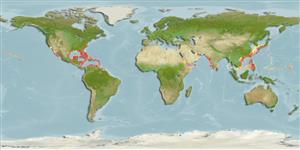Actinopterygii (ray-finned fishes) >
Tetraodontiformes (Puffers and filefishes) >
Monacanthidae (Filefishes)
Etymology: Stephanolepis: Greek, stephanos = crown + Greek, lepis = scale (Ref. 45335).
Environment / Climate / Range
Ecology
Marine; reef-associated; depth range ? - 80 m (Ref. 5217). Subtropical, preferred ?; 37°N - 7°N
Western Atlantic: Bermuda, North Carolina (USA), and northern Gulf of Mexico to southeastern Brazil (Ref. 57756). Indo-Pacific (Ref. 26165).
Size / Weight / Age
Maturity: Lm ? range ? - ? cm
Max length : 20.0 cm TL male/unsexed; (Ref. 3790); common length : 10.0 cm TL male/unsexed; (Ref. 3790)
More common in offshore areas, including floating seaweed and flotsam, and around islands. Juveniles are associated with floating seaweeds (Ref. 3790). Probably feeds on plants and small invertebrates (Ref. 3790). Generally considered as trash fish, rarely consumed (Ref. 3790).
Life cycle and mating behavior
Maturity | Reproduction | Spawning | Eggs | Fecundity | Larvae
Smith-Vaniz, W.F., B.B. Collette and B.E. Luckhurst, 1999. Fishes of Bermuda: history, zoogeography, annotated checklist, and identification keys. American Society of Ichthyologists and Herpetologists Special Publication No. 4. 424 p. (Ref. 35505)
IUCN Red List Status (Ref. 115185)
CITES (Ref. 94142)
Not Evaluated
Threat to humans
Reports of ciguatera poisoning (Ref. 30911)
Human uses
Fisheries: subsistence fisheries
More information
ReferencesAquacultureAquaculture profileStrainsGeneticsAllele frequenciesHeritabilityDiseasesProcessingMass conversion
Tools
Special reports
Download XML
Internet sources
